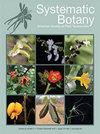Phylogeny, Classification, and Character Evolution of Acalypha (Euphorbiaceae: Acalyphoideae)
IF 0.8
3区 生物学
Q4 EVOLUTIONARY BIOLOGY
引用次数: 1
Abstract
Abstract Acalypha (Euphorbiaceae: Acalyphoideae) is a large, monophyletic genus distributed worldwide in tropical and subtropical regions, with a few species extending into temperate areas of southern Africa, Asia, and North and South America. We reconstructed phylogenetic relationships within the genus using DNA sequences from the plastid ndhF and trnL-F regions and the nuclear ribosomal ITS region, sampling 142 species to represent the geographic, morphologic, and taxonomic diversity with the genus, resulting in a 162 (158 in Acalypha) terminal and 3847 character combined dataset. Bayesian and maximum likelihood reconstructions based on the combined dataset yielded a tree with a generally well-supported backbone and several strongly supported clades. Our results strongly supported the monophyly of Acalypha subg. Acalypha as currently recognized but showed that A. subg. Linostachys and almost all other infrageneric taxa recognized in the most recent comprehensive classification of the genus were not monophyletic. We therefore propose a new subgeneric classification comprising A. subg. Acalypha, A. subg. Androcephala, A. subg. Hypandrae, and A. subg. Linostachys (s.s.). Our results also shed light on relationships within some species groups, including in what has been treated as a broadly defined A. amentacea, in which we recognize A. amentacea, A. palauensis comb. nov., and A. wilkesiana as distinct species. Bayesian ancestral state estimations based on the phylogeny of Acalypha demonstrated that inflorescence position and sexuality and habit show high homoplasy, especially within A. subg. Acalypha, and that inflorescence position and habit exhibit correlated evolution.Acalypha的系统发育、分类和特征演化(大戟科:Acalyphaideae)
摘要Acalypha(大戟科:Acalyphoideae)是一个大型的单系属,分布在世界各地的热带和亚热带地区,少数物种分布在非洲南部、亚洲、北美洲和南美洲的温带地区。我们使用来自质体ndhF和trnL-F区域以及核核糖体ITS区域的DNA序列重建了该属内的系统发育关系,采样了142个物种来代表该属的地理、形态学和分类学多样性,得到了162个(在Acalypha中为158个)末端和3847个字符的组合数据集。基于组合数据集的贝叶斯和最大似然重建产生了一棵树,该树具有通常支持良好的主干和几个强烈支持的分支。我们的研究结果有力地支持了Acalypha亚属的单系性。Acalypha是目前公认的,但显示A.亚属。在该属的最新综合分类中,Linostachys和几乎所有其他亚属分类群都不是单系的。因此,我们提出了一个新的亚属分类,包括a.subg。Acalypha,A.亚属。雄头蛛,A.亚属。Hypandrae和A.subg。Linostachys(s.s.)。我们的研究结果还揭示了一些物种群内的关系,包括被广泛定义的a.damentacea,其中我们识别a.damentacia,a.palauensis comb。nov.和A.wilkesiana作为不同的物种。基于Acalypha系统发育的贝叶斯祖先状态估计表明,花序位置、性和习性表现出高度同源性,尤其是在A.subg中。Acalypha和花序的位置和习性表现出相关的进化。
本文章由计算机程序翻译,如有差异,请以英文原文为准。
求助全文
约1分钟内获得全文
求助全文
来源期刊

Systematic Botany
生物-进化生物学
CiteScore
1.80
自引率
10.00%
发文量
72
审稿时长
6-12 weeks
期刊介绍:
Systematic Botany Monographs is a series of peer-reviewed taxonomic monographs and revisions published the American Society of Plant Taxonomists. ISSN 0737-8211, ISBN prefix 978-0-912861. No; volumes of Systematic Botany Monographs must be ordered separately. ASPT membership inludes only a subscription to the quarterly journal Systematic Botany. SBM is supported by sales, author"s subsidies, and donations.
 求助内容:
求助内容: 应助结果提醒方式:
应助结果提醒方式:


